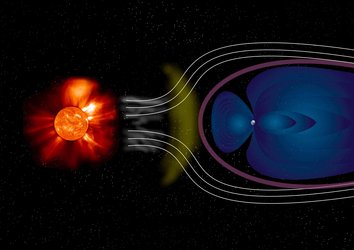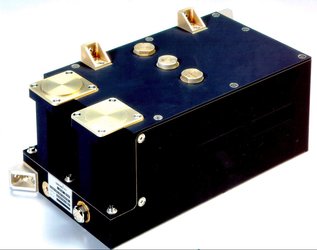Navigation satellites contend with stormy Sun
Just as we grow used to satellite navigation in everyday life, media reports argue that a coming surge in solar activity could render satnav devices useless, perhaps even frying satellites themselves. Is it true? No.
It is a fact that variations in the gigantic unshielded fusion reactor we call the Sun have effects that extend far out into the Solar System. And the solar activity follows a roughly 11-year ‘sunspot cycle’. That means the next ‘solar maximum’ – solar max for short – is due in 2013, not long after ESA launches its first four operational Galileo satellites.
“These Galileo In-Orbit Validation (IOV) satellites will indeed go up during a period of enhanced solar activity,” explains Bertram Arbesser-Rastburg, head of ESA’s Electromagnetics and Space Environment division.

“But the solar max is hardly a surprise event. Astronomers counting sunspots have tracked the solar cycle for more than 250 years. All the indications are this solar max will not be especially energetic – the last solar minimum has been unusually long and deep.”
“So it’s reassuring the Galileo satellites won’t be faced with the worst of the worst on day one. But in any case, they have indeed been built to endure the worst of the worst: even then, they would not fail.”
Satellites proofed against solar flares

The Sun has various potential impacts that satnav system designers must take account of. The first can indeed affect satellites themselves: electromagnetic radiation and charged particles from solar flares can disrupt satellite electronics, induce potentially harmful electrostatic charging and damage onboard materials.
All satellites run these risks but for satellite navigation constellations, the danger is severe. Placed at relatively high altitudes – 22 000 km in the case of Europe's Galileo – they pass through belts of charged particles funnelled by Earth’s magnetic field.

The satellites are built with radiation-hardened components and shielding, and boast redundancy in key subsystems. Error detection and correction routines guard against charged particles randomly ‘flipping’ bits of computer memory.
Galileo satellites were designed with precise data on the radiation hazard they faced: in 2005 and 2008 a pair of test satellites, Galileo In Orbit Validation Element (GIOVE) –A and –B, were launched into the constellation’s future orbit. The satellites were fitted with radiation monitors, still returning data to this day.
Our Sun influencing the ionosphere

The Sun also has a continuing influence on the outermost layers of Earth’s atmosphere, with energetic solar radiation splitting scanty air molecules to form an electrically-charged ‘ionosphere’. Radio pioneers used the ionosphere to reflect signals beyond Earth’s horizon, but for satellite navigation it is more a hindrance than a help.
“Dynamic in nature – especially around where the Sun is shining – the ionosphere may cause noisy scintillations leading to ground receivers losing their satellite locks,” added Arbesser-Rastburg.
“Depending on its local density or ‘total electron count’, the ionosphere can also delay a signal passing through it, amounting to a navigation error on the order of tens of metres.”
Dual receivers receiving two different frequency signals can correct for most of this error, although such receivers tend to be too bulky for in-car or personal use. Smaller GPS systems rely on a regularly-updated error estimate broadcast in the satellite signals themselves.
Increasing certainty in stormy times

Benefiting from four decades of computer advances since the GPS system was designed, each Galileo receiver incorporates a sophisticated ionosphere-modelling plug-in for error estimation – GPS makes use of a simplistic 2D ‘eggshell’ ionosphere model instead.
Added certainty is given by regional overlay systems: the Wide Area Augmentation System (WAAS) for North America and the European Geostationary Navigation Overlay Service (EGNOS) for Europe, with other systems in development.

“What EGNOS offers is an assurance of integrity for European users of GPS and later Galileo signals,” explained Arbesser-Rastburg.“As well as checking the correctness of satellite orbits and clocks, its pan-European network of ground stations measure small changes in the total electron content of the vertical ionosphere above them to deliver local corrections. This is vital when it comes to planned 'safety-of-life’ uses such as civil aviation.
“In the worst case – perhaps during a geomagnetic storm, when an incoming coronal mass ejection completely churns up the ionosphere – the system might tell the user not to rely on it at all. But that would not be a total shutdown, just local unavailability on a scale of hundreds of kilometres, like getting caught up in an incident of bad weather – except this would be space weather.”
In parallel with rolling out Galileo, the Agency is also putting together a Space Situational Awareness programme, combining ground- and space-based assets to increase operational knowledge of space conditions. So while space weather is likely to affect the operational Galileo system in limited ways, more accurate forecasting will be there to mitigate these factors.















 Germany
Germany
 Austria
Austria
 Belgium
Belgium
 Denmark
Denmark
 Spain
Spain
 Estonia
Estonia
 Finland
Finland
 France
France
 Greece
Greece
 Hungary
Hungary
 Ireland
Ireland
 Italy
Italy
 Luxembourg
Luxembourg
 Norway
Norway
 The Netherlands
The Netherlands
 Poland
Poland
 Portugal
Portugal
 Czechia
Czechia
 Romania
Romania
 United Kingdom
United Kingdom
 Slovenia
Slovenia
 Sweden
Sweden
 Switzerland
Switzerland






























